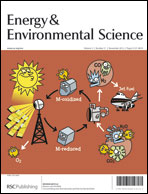Abstract
There is a current intense interest in water electrolysis as a means of generating or storing energy as hydrogen. The water oxidation step typically requires high overpotentials, creating a significant energy loss in the process. In this work we report for the first time water oxidation over a MnOx electrocatalyst at low overpotentials (∼150 mV) in butyl ammonium bisulfate electrolytes (aqueous 0.4 M and hydrated ionic liquid 50/50). The catalyst–electrolyte combination produces currents of the order of 1 mA cm−2 at 150 mV overpotential. A similar experiment in an inorganic electrolyte produces only negligible currents on this catalyst. The product is shown by permanganate oxidation to be predominantly hydrogen peroxide dissolved in the electrolyte. This was confirmed by the preparation of model solutions directly from hydrogen peroxide which were shown to behave similarly to the electrochemically prepared solutions. Ab initio calculation of possible solvated hydrogen peroxide structures in the electrolyte suggests that the hydrogen peroxide is stabilised by a hydrogen bonded complex involving the amine. The hydrogen peroxide solution is shown to be stable for several hours, to days, depending on the concentration, but can be rapidly decomposed into oxygen by a MnO2 catalyst. The process could thus be of interest both as part of a water splitting scheme as well as a route to hydrogen peroxide for chemical use.

- This article is part of the themed collection: Catalysis for Clean Energy

 Please wait while we load your content...
Please wait while we load your content...